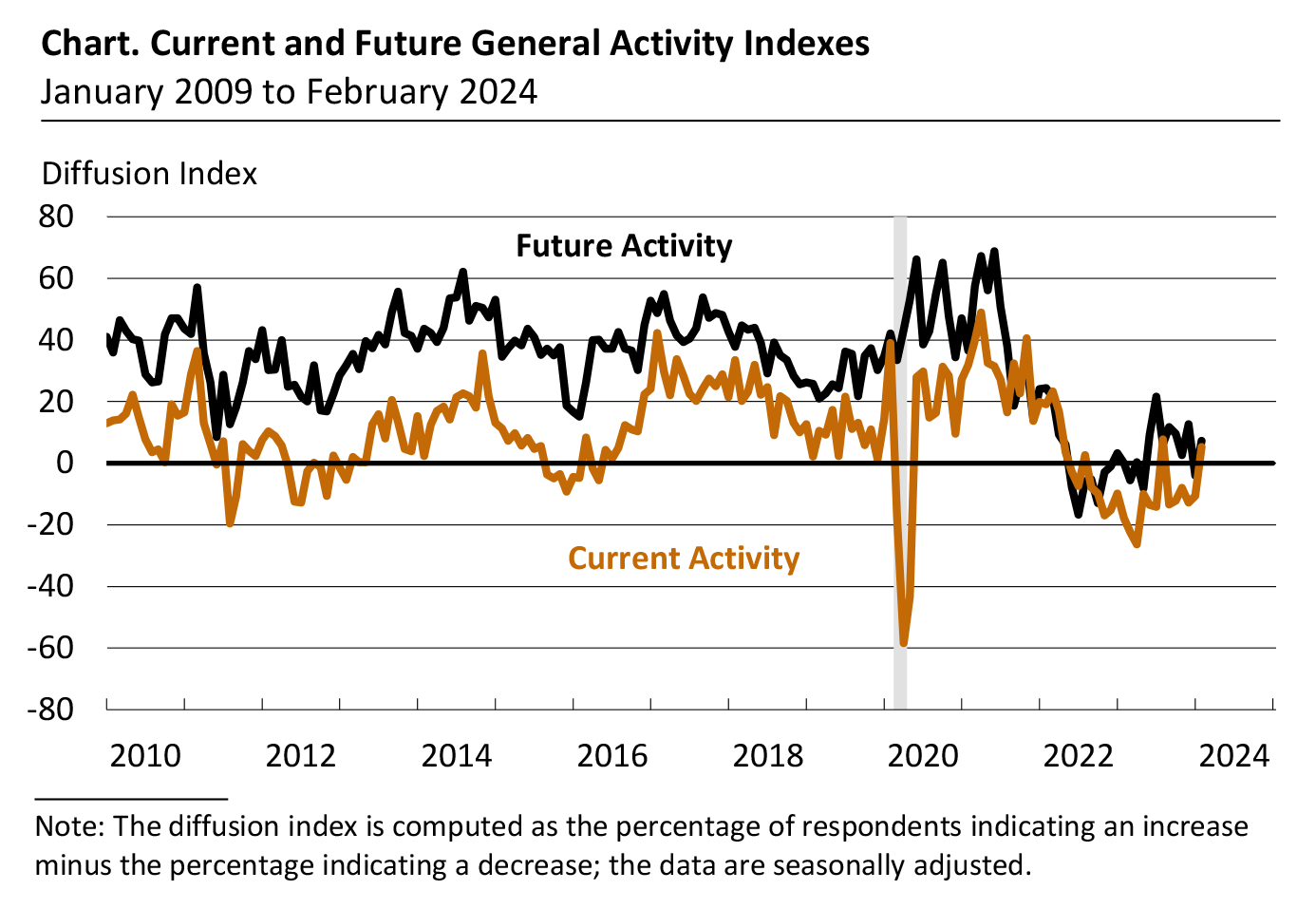February 2024 Manufacturing Business Outlook Survey
Note: Survey responses were collected from February 5 to February 12.
Manufacturing activity in the region expanded overall, according to the firms responding to the February Manufacturing Business Outlook Survey. The survey’s indicators for current general activity and shipments rose and turned positive. The indicator for new orders also rose but remained negative. The employment index suggests declines in employment overall. Both price indexes indicate overall increases in prices but remain below their long-run averages. The survey’s broad indicators for future activity rose, suggesting more widespread expectations for overall growth over the next six months.
Current Indicators Are Mixed
The diffusion index for current general activity rose 16 points to 5.2 in February, its first positive reading since August (see Chart). This is only the index’s fourth positive reading since May 2022. More than 27 percent of the firms reported increases in general activity this month (up from 16 percent last month), while 22 percent reported decreases (down from 26 percent); 45 percent reported no change (down from 52 percent last month). The index for new orders rose 13 points but remained negative at -5.2. The current shipments index turned positive, rising from -6.2 in January to 10.7 in February.
On balance, the firms reported a decline in employment. The employment index fell 9 points to -10.3 in February, its lowest reading since May 2020. Most firms (78 percent) reported no change in employment levels this month, while the share of firms reporting decreases (15 percent) exceeded the share reporting decreases (4 percent). The average workweek rose from -0.9 to 1.4 this month.

Price Indexes Remain Below Long-Run Averages
On balance, the firms continued to report overall increases in prices. However, most firms reported no change in prices, and both price indexes remained below their long-run averages. The prices paid index increased 5 points to 16.6 in February. Almost 21 percent of the firms reported increases in input prices, while 4 percent reported decreases; 70 percent of the firms reported no change. The current prices received index was little changed at 6.2. Over 11 percent of the firms reported increases in prices received for their own goods, 5 percent reported decreases, and 81 percent reported no change.
Firms Experience Lower Increases in Own Prices
In this month’s special questions, the firms were asked to forecast the changes in prices of their own products and for U.S. consumers over the next four quarters. Regarding their own prices over the next year, the firms’ median forecast was for an expected increase of 3.0 percent, unchanged from when this question was last asked in November. The firms reported a median increase of 3.0 percent in their own prices over the past year, down from 5.0 percent last quarter. The firms’ median forecast for the rate of inflation for U.S. consumers over the next year was 3.0 percent, down from 4.0 percent in November. Regarding the long run, the firms’ median forecast for the 10-year average inflation rate was unchanged at 3.0 percent.
Most Future Indicators Strengthen
The diffusion index for future general activity rose from -4.0 in January to 7.2 in February (see Chart). The share of firms expecting increases in activity over the next six months (27 percent) exceeded the share expecting decreases (20 percent); 48 percent expect no change. The future new orders index rose 15 points to 24.2, while the future shipments index jumped 21 points to 26.7. The firms expect overall increases in employment over the next six months, and the future employment index rose 4 points to 4.9. The future capital expenditures index rose 5 points to 12.7, its highest reading since December 2022.
Summary
Responses to the February Manufacturing Business Outlook Survey suggest an overall increase in regional manufacturing activity this month. The indicators for current activity and shipments turned positive, while the new orders index rose but remained negative. On balance, the firms indicated a decline in employment, and the current price indexes continue to suggest overall increases in prices. The survey’s broad indicators for future activity strengthened, suggesting more widespread expectations for growth over the next six months.
Special Questions (February 2024)
| Please list the annual percent change with respect to the following: | ||
|---|---|---|
|
|
Current |
Previous (Nov. 2023) |
| For your firm: | ||
| Forecast for next year (2024Q1–2025Q1) | ||
| 1. Prices your firm will receive (for its own goods and services sold). | 3.0 | 3.0 |
| 2. Compensation your firm will pay per employee (for wages and benefits). | 4.0 | 4.0 |
| Last year's price change (2023Q1–2024Q1) | ||
| 3. Prices your firm did receive (for its own goods and services sold) over the last year. | 3.0 | 5.0 |
| For U.S. consumers: | ||
| 4. Prices U.S. consumers will pay for goods and services over the next year. | 3.0 | 4.0 |
| 5. Prices U.S. consumers will pay for goods and services over the next 10 years (2024–2033). | 3.0 | 3.0 |
| The numbers represent medians of the individual forecasts (percent changes). For question 5, firms reported a 10-year annual-average change. | ||
Return to the main page for the Manufacturing Business Outlook Survey.